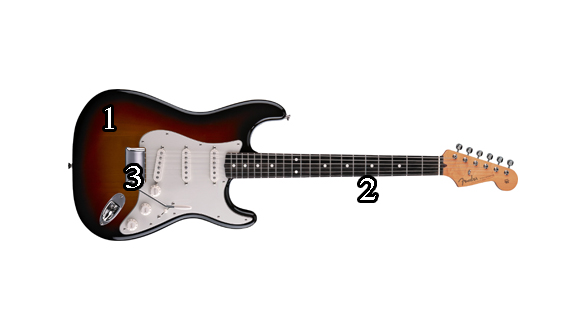Throughout the early sixties, the Newport Folk Festival provided a spotlight for folk royalty like Joan Baez, Johnny Cash, and Howlin’ Wolf, under the assumed context that they’d uphold the festival’s acoustic roots.
So when a young, defiantly-haired Bob Dylan—who had previously established himself as the festival’s darling in ’63 and ’64 with earnest, socially conscious anthems like “Blowing in the Wind,” using no more than an acoustic guitar and a harmonica—sauntered onto the 1965 festival’s stage with a Fender Stratocaster strapped purposefully to his chest, it wasn’t only a big “F-you” to an aging folk establishment, but a watershed moment for pop music as a whole. Drawing a chaotic mix of boos and cheers, Dylan’s plugging in altered pop music’s narrative forever. It was brash. It was annunciative. And it changed the way we experience rock & roll.
[youtube=”http://www.youtube.com/watch?v=S1TKUk9nXjk”&w=450%5D
–
“Everything was so low key in those days,” says photographer and Fender historian John Peden, who documented Dylan at the ’65 festival. “[Dylan plugging in] was challenging. If you were in a movie theater, watching a screen of a certain size and suddenly it’s cinerama widescreen, it’s in your face—it requires an adjustment.”
“I think some of the crowd had trouble adjusting to the volume and the sound,” he says. “It wasn’t Hedy West with a banjo. It was loud. It was aggressive.”
The electric guitar itself is important because it signified much more than a shift in volume or dynamics. While “Like a Rolling Stone” was already charting the airwaves (the crowd shouldn’t have been as surprised as they were, notes Peden), the silhouette of Dylan wielding the classic Strat—as modern and far removed from an acoustic guitar as there was in the ’60s—indicated a monumental shift in rock music’s DNA.
Sure, Dylan could’ve amplified (or even “plugged in”) a more traditional, hollowed-out guitar; the fact that he chose the Strat was a conscious decision not to.
“He definitely had a confrontational air, and he sort of invited that,” recalls Peden. “Whether he knew it or not was part of his schtick at the time.”
In short, the Stratocaster sparked a move away from the lighthearted ideologies of the late fifties and early sixties. Its very shape connoted complexity, while its makeup put the “rock” back into “rock & roll.”
The ’62 Strat Dylan played was rumored to be borrowed from one of the members of his backing band at the time, and sources say it’s likely still in Bob’s possession. The backing band included Mike Bloomfield (joining Dylan with a Telecaster) and other members of the Paul Butterfield Blues Band, who played at a workshop earlier that afternoon. It’s important to note that they also played a bluesy electric set—Dylan wasn’t the first at the Newport Folk Festival, but because of his rootsy expectations, he immortalized himself as the most important.
Here’s a look at a few of the legendary guitar’s likely specs.
1. The Body
The paint was a now-ubiquitous three tone sunburst (pictured above) and was likely carved out of Fender’s preferred alder wood, which lends the guitar a plucky, brighter tone to correlate with an innovative “comfort contoured” body—strikingly different from the more rigid Telecaster models that dominated the music scene prior. The body’s gaping cutaway made it a favorite of future players like Clapton and Hendrix, which allowed for easy access to the instrument’s higher registers. In the live ’65 recordings of Dylan taking stage and launching into “Like a Rolling Stone,” the guitar’s illuminated growl drowned out the provocative singer’s signature rasp.
2. The Fretboard and Neck
The fretboard had 21-frets and was carved out of rosewood, reshaped to a thinner, more nimble shape than its ’57 predecessor. The newly introduced “C”-shaped neck (or back shape) is not only definitive of the modern Stratocaster and most other guitars, but allows for a more ergonomic finger placement around the fretboard. “I think it would have been very different had he not been holding the Stratocaster,” says Peden. “I think that because Dylan’s lyrics get so much attention, his guitar playing and his musicianship are definitely underrated. The guy is a fierce rhythm guitar player.”
3. The Pick-Ups
The ’62 Strat utilized S/S/S single-coil pickups at the bridge, middle, and neck, which could be selected among using a three-blade switch. In hindsight the warm vintage tone is one of the most sought after in rock music (with reverse-engineered reissues still costing upwards of $189 per set). It’s important to note, however, that Dylan probably didn’t give a rat’s a** about what was actually inside the guitar. Uniformed in a leather jacket, shadowy black Wayfarers, with a dangling cigarette never far behind, more than anything he probably just wanted the instrument loud enough to raise hell, the residual embers of which would light the torch towards rock & roll’s high-voltage future.
More on TIME.com:
A Walking Tour of Bob Dylan’s Greenwich Village


